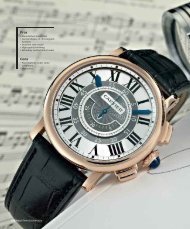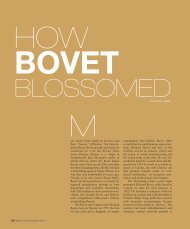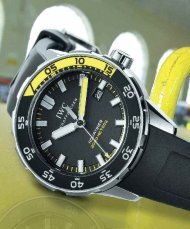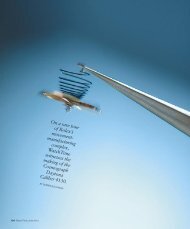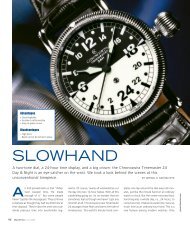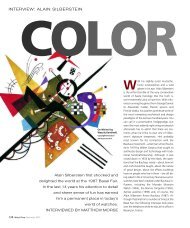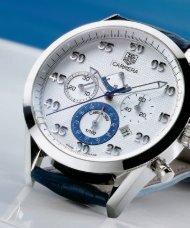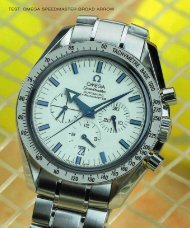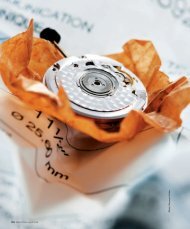pro & con: horizontal vs. vertical coupling - WatchTime
pro & con: horizontal vs. vertical coupling - WatchTime
pro & con: horizontal vs. vertical coupling - WatchTime
Create successful ePaper yourself
Turn your PDF publications into a flip-book with our unique Google optimized e-Paper software.
PRO & CON: HORIZONTAL VS. VERTICAL COUPLINGVERTICALJEROME LAMBERTCEO OF JAEGER-LECOULTRE:The Extreme WorldChrono (left) and itsmotor, JLC Caliber752, shown with itsrotor removed. The<strong>vertical</strong> <strong>coupling</strong>(center) has a returnto-zeroheart, achronograph wheeland a copper-coloredfourth wheel.“Jaeger-LeCoultre’s engineers andwatchmakers made reliability and precisiona priority when they developed thenew Caliber 753. For this reason, youwon’t find the <strong>con</strong>ventional toothedwheels of a <strong>horizontal</strong> <strong>coupling</strong> mechanismto operate the chronograph’s functions.Instead, you’ll find two disks locatedbetween the fourth wheel and thechronograph’s counters. These diskstransfer energy between those components.They also ensure that the chronographstarts precisely and reliably. Usersimmediately notice the difference becausethe center-mounted se<strong>con</strong>ds handstarts instantly, without delay and withoutthe backward motion often seen inchronographs with <strong>horizontal</strong> <strong>coupling</strong>.Other important advantages aren’t noticeableat first glance, but they play animportant role because they enhanceprecision. There are no teeth in the <strong>coupling</strong>,so the optimum transfer of energyoccurs without loss. This means that thebalance’s amplitude remains <strong>con</strong>stant, regardlessof whether the chronograph isswitched on or not. And our technicianswent one step further: they put two jewelsinto the interior of the <strong>coupling</strong> mechanism.These rubies reduce friction to anegligibly low value when the chronographis motionless (because the fourthwheel <strong>con</strong>tinues to turn <strong>con</strong>stantly). Furthermore,this <strong>coupling</strong> is extremelyshock-resistant, thus making the watchvery reliable on the wrist. A strong springholds the two disks together firmly whenthe chronograph is running. The disk<strong>coupling</strong> embodies precision and reliability.Why isn’t it used more often? Becauseit’s difficult to manufacture and assemble.The utmost meticulousness and precisionare required.”troduced in 2005, has 279 components. PatekPhilippe’s Caliber CH 28-520 IRM Q 24H optsto do without a <strong>con</strong>tinuously running se<strong>con</strong>dshand. Thanks to low-friction <strong>vertical</strong> <strong>coupling</strong>,this chronograph’s center-mounted se<strong>con</strong>dshand can be allowed to rotate <strong>con</strong>tinually. Itcan be started simply by operating the flybackbutton.Another development came in 2006 fromChopard. The L.U.C 10 CF combines <strong>vertical</strong>friction <strong>coupling</strong> and an instantaneous returnto-zeromechanism, along with a small and<strong>con</strong>tinually running se<strong>con</strong>ds hand that can doa rather nifty trick. If the return-to-zero buttonis activated while the crown is extracted intothe time-setting position, the se<strong>con</strong>ds hand returnsto 12 in the blink of an eye.Vertical <strong>coupling</strong> does, however, have onedisadvantage. As in an automobile, the <strong>coupling</strong>occurs largely out of sight, whereas the<strong>horizontal</strong> arrangement is much more attractiveand eye-catching. Once again, it appearsthat even for watch lovers, it is difficult to haveone’s cake and eat it too.■96 <strong>WatchTime</strong> April 2007



